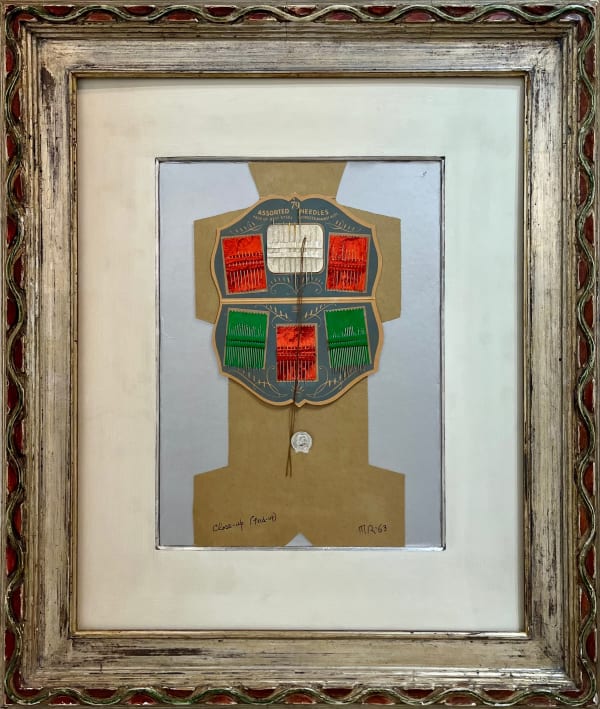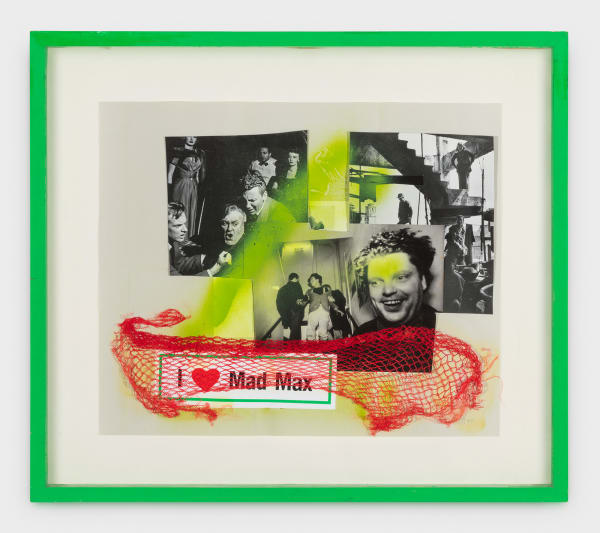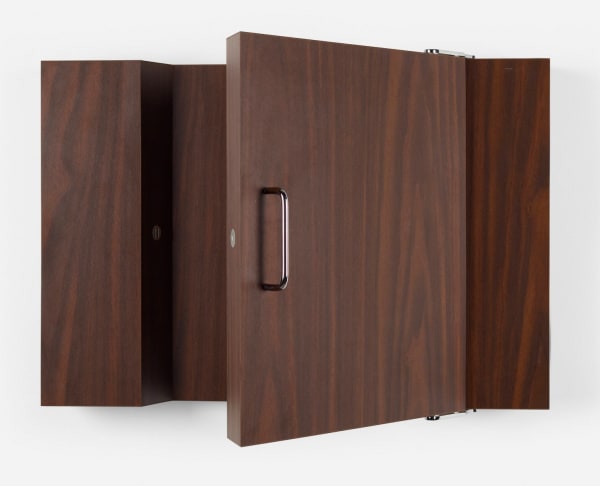ENRICO BAJ: Alter Ego and Other Hypotheses
-
Overview
CELEBRATING THE ARTIST'S CENTENNIAL
with additional works by:
RICHARD ARTSCHWAGER · HANS BELLMER · KERSTIN BRÄTSCH · WILLIAM COPLEY · JEAN DUBUFFET · MARCEL DUCHAMP · NICOLE EISENMAN · ASGER JORN · MARTIN KIPPENBERGER · JONATHAN MEESE · FRANCIS PICABIA · MAN RAY · and others
With a passion for the eccentric and a strong iconoclastic impulse, Enrico Baj (1924-2003) was one of the central figures of the Italian Neo-Avant-Garde. Born in Milan, his art and writings played an instrumental role in influential movements, from Dada and Surrealism to Art Informel and CoBrA, as well as the Nuclear Art movement, which he cofounded in 1951.
Heir to the Surrealist-Dadaist spirit, and an experimenter in original styles and techniques, Baj departed from gestural abstraction in the mid-1950s and honed an idiosyncratic iconography for his paintings, drawings, collages, objects, and sculptures, defiantly embracing figuration and kitsch symbols, and subverting conventions. Ever since his participation in the Venice Biennale in 1964, Baj’s art has been exhibited in all the major European museums and frequently in the United States since 1960.
Titled after Alterego e altre ipotesi, a publication which Enrico Baj designed in collaboration with Italian poet and art critic Roberto Sanesi in 1970, the exhibition features a selection of works by Baj dating between 1954 and 2002 in dialogue with works by artists from his time, most of whom he was in close contact with, and artists from younger generations with whom we would like to imagine Baj in conversation today, including Martin Kippenberger, Jonathan Meese, Nicole Eisenman and Kerstin Brätsch.
Baj’s oeuvre bears a distinctly political slant, most glaringly in his Generals and Ladies series. The Generals are pseudo-portraits of military generals, formulated from the details of a military uniform; the Ladies are composed of the debris of a household and its upkeep. The artist mocks the grandiose self-image of the military general, as well as the outrageous performance required of aristocratic society. Baj’s unique form of artistic rebellion stands out from that of his peers; it is perhaps most comparable to the anti-establishment attitude and style of Jean Dubuffet.
It is intriguing to note the connections between Baj and his contemporaries. Active in the Milan art scene, he engaged and showed alongside artists like Francis Picabia, Marcel Duchamp, and Lucio Fontana. He owned at least three works by Picabia, one directly acquired from the artist himself. His encounter with Asger Jorn in 1953 led to the establishment of the International Movement for an Imaginist Bauhaus opposing the rationalization of art. Collaborating not only ideologically but also artistically, Baj and Jorn worked together on Jorn’s well-known Modifications series. Modifications revised found kitsch paintings, emphasizing the critique inherent in appropriating low-brow artwork.
Before meeting Marcel Duchamp, Baj belonged to a generation of artists revisiting the Dadaist’s work upon the publication of Duchamp’s writings and monograph in the late 1950s. Baj exhibited in the 1960 International Surrealist Exhibition, which Duchamp co-curated with André Breton, proving the awareness was mutual.
Duchamp and Baj finally met on Baj’s trip to New York in 1961 for the Museum of Modern Art exhibition, The Art of Assemblage. Baj and Duchamp, both participating in the landmark show, struck up a close friendship that would lead to support of each other’s careers and, eventually, artistic collaboration on a 1965 version of Duchamp’s L.H.O.O.Q. Their friendship, along with their shared sense of humor and embrace of the banal, established a living connection between Duchamp’s Dada and Baj’s Neo-Dada. What united these artists - Duchamp, Picabia, Jorn, Baj - was the humor and double entendre present in their works, rooted in the observation of real life while overlapping with several different Modern/Post-War movements.
André Breton was also friends with Baj; Breton consistently invited Baj to exhibit with the Surrealist Movement. Breton, a prolific writer and poet, penned a lengthy essay about Enrico Baj, which was published in the third edition of his book Le Surréalisme et la Peinture. Baj’s relationship with Breton and acceptance into Surrealist institutions validates his enormous range as an artist and his category-defying legacy.
Both Breton and Max Ernst avidly collected Native American art, and frequently showed katsina dolls alongside their own works in several notable exhibitions. It is possible, even likely, that Baj encountered these dolls at their homes. Katsina dolls, known as tithu to the Hopi, are visual representations of the katsinam, the essential life force of all animate beings. The dolls unite the creative and the utilitarian, serving as a method of spiritual relief from the demands of modern life. Baj related to his art in a similar manner, channeling the raw elements of his lived experience into his work.
Enrico Baj maintained close ties with the pioneers of Dada and Surrealism, co-founding the Pataphysic Institute of Milan in 1963, an Italian equivalent of the Parisian College de Pataphysique de France, with Man Ray and others.
William Copley and Baj mesh stylistically in their collage-like aesthetic and adoption of bright color. In 1959, the two created at least two artworks together, Personaggi e segnali (Characters and Signals) and Gli amanti (The Lovers). This sort of artistic communion typifies the exchange occurring within the milieu of artists surrounding both Baj and Copley, another example of which presents itself in the interpretations Baj made of his fellow artists in works like Bonjour Max Ernst (1975) and Ritratto di Lucio Fontana (Portrait of Lucio Fontana). Together, Enrico Baj and Piero Manzoni produced Arrivo dell’ultracorpo (Arrival of the Body Snatcher) in 1958 with oil paint, collage, mixed media and kaolin, while Fontana and Baj collaborated at Composizione con ultracorpo (Composition with Body Snatcher) in 1959 with oil paint, collage and stones on canvas. Fontana Baj Manzoni was the title of two exhibitions mounted in Italy in 1958, when the third issue of the ‘nuclear’ periodical “Il Gesto” edited by Baj, Manzoni and Sergio Dangelo featured a cover riddled with holes, conceived by Fontana, and reproduced on its pages the latest works by contemporary artists and poets such as Gillo Dorfles, Jean Dubuffet, Marcel Duchamp, Asger Jorn, and others.
Throughout his life, Baj was in close contact with poets and intellectuals, both in Italy and abroad, and collaborated on numerous occasions to produce prints or original multiples for several artist books. In 1999, Baj confirmed once again his deep commitment to literature with a series of 164 portraits inspired by Marcel Proust’s Guermantes.
This year, one hundred years after Baj’s birth, several museums in Italy are paying homage to the master of Dames and Generals, of Meccanoes and Body Snatchers; the irreverent genius, light-hearted anarchist, and pataphysical artist.
From October 2024 to January 2025, an exhibition at Palazzo Reale in Milan will feature Enrico Baj’s art through the words of great writers from the 20th century who intertwined their works with Baj’s lyrical and caustic images, such as André Breton, Raymond Queneau, Marcel Proust, Italo Calvino, Edoardo Sanguineti, and Umberto Eco, among others.
-
LEARN MORE
-
Installation Views
-
-

-

-

-
 Asger JornThe Little Grey Home in the West (Modification), 1959oil on canvas on found painting19 x 39 1/2 in (48.3 x 100.3 cm)
Asger JornThe Little Grey Home in the West (Modification), 1959oil on canvas on found painting19 x 39 1/2 in (48.3 x 100.3 cm)
framed: 28 x 49 x 2 in (71.1 x 124.5 x 5.1 cm) -
 Francis PicabiaComposition abstraite, 1945oil on canvas21 5/8 x 18 1/8 in (55 x 46 cm)
Francis PicabiaComposition abstraite, 1945oil on canvas21 5/8 x 18 1/8 in (55 x 46 cm) -

-

-

-

-

-

-
 Enrico BajGenerale con il suo aiutante di campo, 1959collage passementerie and decorations on fabric on canvas35 1/2 x 33 5/8 in (90.2 x 85.5 cm)
Enrico BajGenerale con il suo aiutante di campo, 1959collage passementerie and decorations on fabric on canvas35 1/2 x 33 5/8 in (90.2 x 85.5 cm) -

-

-

-

-

-

-
 Man RayClose-up, Fold-up, 1963collage, paper and pinheads15 x 11 in (38 x 28 cm)
Man RayClose-up, Fold-up, 1963collage, paper and pinheads15 x 11 in (38 x 28 cm)
framed: 26 1/4 x 22 3/8 x 1 7/8 in (66.7 x 56.8 x 4.8 cm) -

-

-
 Martin KippenbergerI Love Mad Max, 1985adhesive sticker, found photographs, red netting, spray enamel, and graphite on paper in artist's frame15 3/4 x 18 7/8 in (40 x 47.9 cm)
Martin KippenbergerI Love Mad Max, 1985adhesive sticker, found photographs, red netting, spray enamel, and graphite on paper in artist's frame15 3/4 x 18 7/8 in (40 x 47.9 cm) -

-

-

-
 Enrico BajFiocco, 1967pencil on paper11 x 7 7/8 in (28 x 20 cm)
Enrico BajFiocco, 1967pencil on paper11 x 7 7/8 in (28 x 20 cm)
Framed: 21 x 17 in (53.3 x 43.2 cm) -

-
 Enrico BajLa Duchessa di Tourzel, 1975pencil on paper22 1/2 x 18 7/8 in (57 x 48 cm)
Enrico BajLa Duchessa di Tourzel, 1975pencil on paper22 1/2 x 18 7/8 in (57 x 48 cm) -
 Enrico BajLa baronessa di Varenne, 1975pencil on paper27 1/2 x 19 3/4 in (70 x 50 cm)
Enrico BajLa baronessa di Varenne, 1975pencil on paper27 1/2 x 19 3/4 in (70 x 50 cm)
framed: 39 x 31 in (99.1 x 78.7 cm) -
 Enrico BajMadeleine Bèjart, l’amica di Molière, 1975pencil on paper27 1/2 x 20 1/8 in (70 x 51 cm)
Enrico BajMadeleine Bèjart, l’amica di Molière, 1975pencil on paper27 1/2 x 20 1/8 in (70 x 51 cm) -

-

-

-

-

-

-
 Marcel Duchamp50th Anniversary of the International Armory Show 1913, 1963print on offset paper44 1/8 x 26 3/8 in (112 x 67 cm)Numbered 97/200
Marcel Duchamp50th Anniversary of the International Armory Show 1913, 1963print on offset paper44 1/8 x 26 3/8 in (112 x 67 cm)Numbered 97/200
-
-
Artist








































